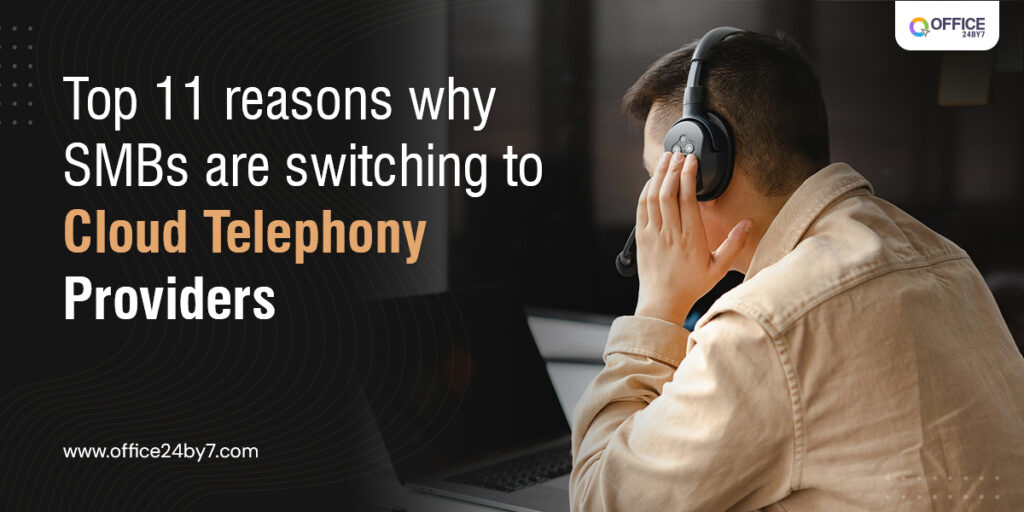
With the advent of cloud telephony providers, the dependency of businesses on legacy phone systems is over. Based on a statistical study 61% of Small to Medium sized businesses are switching to VoIP-based cloud business phone systems. Similar studies also show 91% of the companies, compliance is easier with the use of cloud-based VoIP phone systems.
This blog provides a detailed insight into why small and mid-sized businesses alike have turned to cloud telephony providers as their go-to choice for business communications.
The Challenges Faced by SMBs
- Small businesses and startups have a hard time accommodating the enormous call volumes with their small number of agents. This call volume will gradually increase making it necessary to hire more employees.
- Most mid-sized teams are deprived of any unified communications automation provider. This makes it difficult to manage all communications whether it be inside, outside, blended, or remote teams. The a need for a unified system to bring together all communication data and provide a blended system for efficient communication.
- Legacy phone systems provide outdated features and are viable for security threats.
- Cloud telephony services promote hybrid work functionality which helps to drive better team collaboration.
- SMBs require a value-focused and highly customizable phone system that can help the organization work with greater flexibility and agility.
Comparing Traditional Business Phone System vs. Cloud Telephony System
Now that you have a basic understanding of the issues faced by small and medium-sized businesses in today’s daily life, let’s dive deeper into the differences between traditional phone systems and cloud telephony services.
| Features | Traditional Phone System | Cloud Telephony System |
|---|---|---|
| Hardware Setup | Requires copper lines, phones, and PBX | Requires VoIP endpoints (phones, computers, smart devices) and modems/routers |
| Sound Quality | Analog format, poor quality | Dependent on internet connection and packet loss; usually better quality |
| Call Routing | Generally hardware-based | Included in service plans; are advanced features like auto-attendant, IVR |
| Call Forwarding | Often an extra feature | Built-in with advanced remote call-forwarding capabilities |
| Faxing | Converts scanned documents into electric signals | Uses data networks; more secure with fewer quality issues |
| Long Distance Calls | High costs | Typically unlimited calling in India and Internationally; making it more affordable |
| Scaling Capacity | Needs new licenses, phones, lines from telecom carrier | Easily scalable by adding new lines online |
📑 You May Also Like: Leverage Call Analytics to Enhance Cloud Telephony Solutions
Top 11 Reasons Why SMBs Are Embracing Cloud Telephony Providers
#1 Cloud Telephony Enables Automatic Call Forwarding
The automatic call forwarding feature provided by cloud telephony providers like Office24by7 forwards unanswered calls to a different number so that the caller doesn’t have to hang up and try another number or lose interest while it happens. Agents can create a custom sequence for dialing numbers, add or remove numbers, and even forward calls to the right agents or departments.
#2 Cloud Telephony Provides Call Routing and Call Flow Management
Call routing provides agents with customizable rules that empower call center software. Agents can set rules for specific calls that are focused on any particular department or agent in a department. They can also set rules to route calls and what to do in case no one is available to pick up the call.
Linear, round-robin, skill-based, and location-based, are some of the call routing methodologies from which agents can choose their inbound calls. They can also use call routing to assign calls to agent-based, agent’s call duration, and agent availability, etc.
The call routing feature helps businesses in three ways. First, it lets small businesses set up their system for how calls get answered. Second, callers won’t be stuck on hold forever. Third, it makes sure customers get connected with the right person to fix their problems fast without waiting in long queues over different departments!
#3 Cloud Telephony Providers Enable IVR Virtual Receptionist
This feature uses pre-recorded automated messages and call menus to help callers connect to the right department without wasting their time either waiting for the agent to diagnose their problem or listening to the busy tone. IVR services also allow customers to review their account statuses, make payments, and register complaints without any manual interaction with the agents.
The IVR system uses technology such as DTMF inputs, Natural Language Processing (NLP), or voice recognition, to interact with the customers. The ability to self-service and resolve problems makes it a convenient source of grievance addresses. It also helps relieve agents from frequently asked questions and rather focus on more complex and crucial calls.
#4 Communication Automation Features for Real-Time Monitoring
You can upgrade your customer service game with a suite of call monitoring and recording features designed to empower both managers and agents. Cloud telephony providers do not just let you listen in – but also actively improve communication and foster a customer-centric environment.
Call recording and call whispering features from communication automation service providers give real-time coaching benefits. Managers can provide constructive feedback at the moment with “Call Whisper,” prompting agents with helpful advice without the caller ever knowing. Stuck calls get a quick assist with “Call Barge,” allowing managers to seamlessly take over and steer the conversation back on track.
It promotes effortless review and performance insights. Every interaction is automatically recorded, complete with a transcribed call log stored securely in the cloud. This makes reviewing past calls a breeze, allowing managers to identify common customer pain points, assess agent performance, and ensure the focus stays firmly on the customer (no more scribbling notes during calls!). Plus, call recordings provide a verified record of the conversation for future reference.
Cloud telephony software providers for small businesses translate to a multi-pronged benefit: improve your team’s efficiency, gain valuable customer insights, and guarantee seamless communication – all with a user-friendly suite of call monitoring and recording tools.
#5 Cloud Telephony Streamlines Business Communications and Operations
The biggest benefit of UCaaS is its ability to provide a centralized dashboard, which acts as a single point of contact for seamless syncing of multiple communication channels such as voice calling, SMS texting, video calling, instant chat messaging, and so on.
Imagine agents having everything they need at their fingertips! UCaaS eliminates the hassle of juggling different apps and channels. Even better, agents can see a customer’s entire history in real-time. This means no more repeating information for different agents, leading to a much smoother experience for your customers. The result? Satisfied customers and agents who can get more done in less time – a win-win for everyone!
#6 Use Toll-Free Numbers from Cloud Telephony for both Local and Global Identity
In most instances, virtual number providers give at least one local phone number within their standard plan. Businesses requiring additional local numbers can obtain them directly from the provider through a convenient purchasing process.
This flexibility empowers organizations, regardless of their physical location, to acquire a multitude of local phone numbers, fostering a localized presence within each target region. Additionally, toll-free numbers enable customers to contact the business at no cost, further enhancing accessibility. Furthermore, the utilization of a dedicated business phone number reinforces a professional image and instills confidence in the organization’s clientele.
#7 Use Audio/Video Conferencing for Increased Team Collaboration
The global shift towards remote work has fueled the rise of audio/video conferencing as a cornerstone of effective communication. Businesses are leveraging this technology to bridge geographical divides and facilitate face-to-face interactions between teams, fostering a sense of connection and real-time collaboration. Cloud telephony services further enhance this capability by enabling seamless transitions to video/audio conferencing services with a single click.
This user-friendly approach empowers teams to collaborate effectively, regardless of location. Advanced features like automated meeting reminders, file-sharing functionalities, guest management tools, and in-call chat options streamline business communication and ensure everyone stays on the same page.
For SMBs, these advanced collaboration features offer a game-changing advantage. By replicating the effectiveness of in-person meetings within a virtual environment, VoIP conferencing solutions providers eliminate the need for unnecessary travel and associated costs. This not only fosters stronger connections among geographically dispersed teams but also reduces communication gaps across departments, ultimately leading to heightened employee engagement and increased communication efficiency. In today’s remote and hybrid work environment, cloud telephony software conferencing empowers SMBs to thrive.
#8 Transcribe Voicemails to Text Messages as Visual Voicemails
Visual voicemail, a user-friendly feature also known as voicemail transcription, offers a suite of benefits that streamline communication and enhance efficiency. This innovative technology automatically transcribes voicemail messages and delivers both the transcription and the original audio file directly to the user.
The convenience factor is undeniable. Users can now visually scan and read their voicemails, eliminating the need to listen to each message sequentially. This not only saves time but also allows for quick prioritization and action. Additionally, visual voicemail empowers agents to receive instant notifications of critical voicemail messages, ensuring no calls go unnoticed.
For SMBs, visual voicemail translates to a significant advantage. Agents can leverage the transcribed messages to prioritize callbacks based on urgency or importance. The flexibility to respond via text or email allows for a quicker and more streamlined response process. Most importantly, the readily available transcription eliminates communication gaps between the caller and the agent, ensuring a clear understanding of the message and a more efficient resolution. In today’s fast-paced business environment, visual voicemail empowers SMBs to optimize agent productivity and enhance overall customer experience.
#9 Get Easy CRM Integration for an Accurate and Unified Database
The integration of CRM system features offered by VoIP business phone systems removes the hassle of juggling multiple applications. This seamless integration ensures the CRM system effortlessly connects with your existing business software, creating a unified platform for managing customer interactions.
The “Call Pops” functionality further enhances agent efficiency by leveraging the integrated CRM data. When an inbound or outbound call connects, Call Pops automatically displays relevant customer information on the agent’s screen. This includes valuable details such as recent purchase history, outstanding issues, and customer preferences. With this complete picture of the caller readily available, agents can provide personalized service and address customer needs promptly, eliminating the need to switch between applications and saving valuable time.
This integrated CRM software and Call Pop functionality empower businesses to optimize customer interactions, ensuring a smooth and personalized experience for every caller.
#10 Enable Customer Callback to Improve Customer Satisfaction
Long wait times are a major pain point for callers, often leading to frustration and abandoned calls. VoIP business phone systems address this issue with a user-friendly callback scheduling feature. This innovative functionality empowers callers to avoid lengthy hold times by scheduling a callback at their preferred time and date. Both the caller and the agent receive automatic notifications regarding the upcoming call, ensuring everyone stays informed and prepared.
The benefits of callback scheduling are undeniable. Customers enjoy a significantly improved experience by eliminating the need to wait on hold, enhancing their overall satisfaction. Furthermore, this feature reduces call abandonment rates, ensuring potential customers aren’t lost due to impatience. For agents, callback scheduling improves efficiency during peak call times, allowing them to manage their workload more effectively and provide focused attention to each call. Ultimately, callback scheduling is a win-win for businesses and customers alike.
#11 Get Real-Time Call Analytics for Improving Agent Performance
Real-time call analytics offered by cloud telephony services is a powerful tool for gaining valuable insights into customer interactions and agent performance. This feature goes beyond simply accessing historical data; it empowers users to view customer data and call details in real-time, allowing for immediate adjustments and optimizations.
VoIP phone systems generate comprehensive analytics reports that encompass essential metrics and key performance indicators (KPIs), such as average call duration, speed of answer, daily/weekly/monthly call volume, first call resolution rate, average talk time per agent, and cost per call. These detailed reports illuminate valuable insights into various aspects of your customer service operation.
Call analytics empowers businesses to understand agent performance, identify areas for improvement within training programs, pinpoint peak call times, and gain a comprehensive view of how effectively their call center is functioning. By analyzing what’s working well and what areas need optimization, SMBs can make data-driven decisions to improve customer service delivery, enhance agent productivity, and ultimately achieve their business goals. In essence, real-time call analytics provides a roadmap for continuous improvement and ensures your call center operates at peak efficiency.
📚 Want to Read More? Try Top 10 Sales Automation Software for Small Business
Key Takeaways
For small and medium-sized businesses (SMBs), traditional phone systems are becoming a relic of the past. Cloud business phone systems offer a compelling alternative, packed with advanced features, cost-effective solutions, and unmatched flexibility.
These innovative systems deliver a multitude of benefits:
- Advanced VoIP Features: Cloud-based solutions provide access to cutting-edge VoIP functionalities, enhancing communication capabilities and empowering businesses to operate more efficiently.
- Cost-Effective Value: Cloud phone systems eliminate the need for upfront hardware investments and ongoing maintenance costs, offering a scalable and budget-friendly solution.
- Streamlined Communication: Cloud technology software facilitates seamless communication across various channels, fostering collaboration and improving overall workflow.
- Scalable Plans: Unlike traditional systems, cloud plans adapt to your business needs. Whether you’re a growing startup or an established company, there’s a scalable plan to fit your requirements.
- Increased Agility and Flexibility: Cloud-based systems allow businesses to operate with greater agility. Employees can access the phone system from anywhere with an internet connection, promoting remote work capabilities and a flexible work environment.
Cloud telephony software providers offer a comprehensive and cost-effective solution for SMBs. By “hanging up” on outdated legacy systems and embracing the cloud, businesses can unlock a 360-degree range of benefits – a smart move for any forward-thinking SMB looking to optimize communication, empower their workforce, and achieve their business goals.





